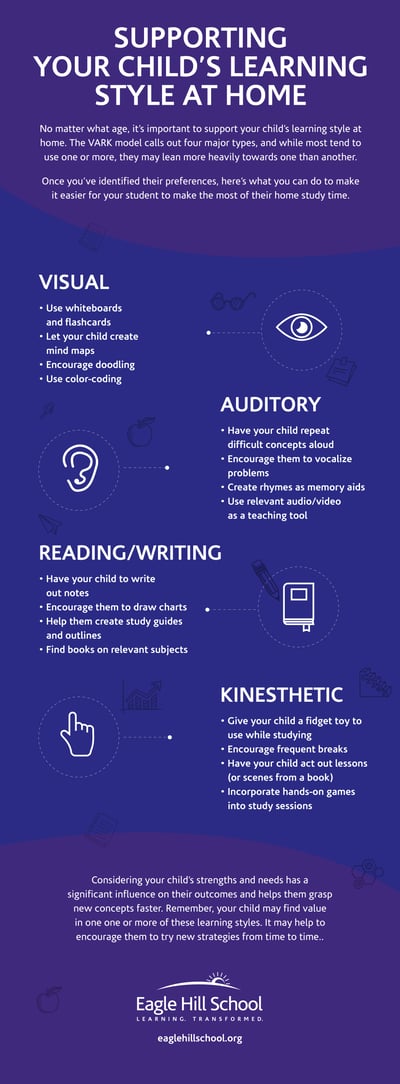It’s no secret that each child is unique—ask any parent with multiple children and they’ll be quick to tell you just how different each child is. From the way they speak to the things they love, each child has particular interests, needs, and preferences of their own.
So why should their learning habits be any different?
Where one young student thrives with hands-on experiments, another might prefer to read an explanation or description. While one child might need to talk out a difficult concept, another might like seeing a detailed diagram.
Knowing your child’s learning style can help them make the most of their time both in the classroom and out of it—but where do you start?
Here’s what you should know about the four main learning styles and how to recognize your child’s needs.
Four Types of Learning Styles
According to educational theorist Neil Fleming’s VARK model of student learning, there are four major types of learning styles. The acronym VARK stands for the four styles: visual, auditory, reading/writing, and kinesthetic.
It’s important to keep in mind that, as in all aspects of life, children rarely fit neatly into a single category! Most children will tend to use one or more learning styles, though they may lean more heavily on one than another.
Visual Learning Style
Also referred to as “spatial” learners, visual learners learn best through observation. They enjoy looking at pictures and diagrams, have active imaginations, and tend to think in images. They work best when they can see demonstrations, or written or drawn instructions.
Auditory Learning Style
These learners pick up information through listening, often preferring to hear instructions or stories instead of reading them. Often, auditory learners like to read out loud and reinforce what they're learning by speaking to others, though this isn’t true for everyone.
Reading/Writing Learning Style
These individuals prefer to learn through words, diving into their summer book list, or perhaps writing their own stories. They often work best in quiet places and may be copious note-takers and avid readers.
Kinesthetic Learning Style
Also called “tactile learners,” kinesthetic learners like to get hands-on. They often excel at physical activities like dance or sports, and they enjoy working with their hands. Some kinesthetic learners have trouble sitting still and need frequent breaks while studying.

How to Identify Your Child’s Learning Style
Because they don’t spend time with their children in an academic setting, some parents think it’s impossible to figure out a child’s learning style without the help of a teacher. However, learning styles often influence a child’s hobbies and personal preferences as well, so you’ll likely find it easy to find out what kind of learner your child is just through critical observation!
Watch your child in action to see how they express themselves, how they spend their time, and how they solve problems.
For example, if you want to know if your child is a visual learner, consider whether they enjoy visual activities like puzzles and art. Do they like taking notes, drawing, or doodling in their notebooks? Do they like looking at pictures, illustrations, maps, or diagrams?
When it comes to auditory learning, consider whether your child likes music, singing, humming, or reading aloud. Do they like chatting with others or asking questions? Do they follow instructions best when they’re spoken aloud? Are they more partial to an audiobook over a hard copy?
Reading and writing learners are often easy to identify, as they tend to spend a great deal of time doing one or both of these tasks. Look for learners who like to curl up with a good book, who write their own stories, or who organize their thoughts with clear notes.
Kinesthetic learners tend to be active, so consider your child’s preferences when it comes to physical activities like dancing or sports. Drawing and games are other common pastimes, and you may notice your kinesthetic learner has a hard time staying focused on a task that isn’t hands-on.
If you struggle to identify your child’s learning style, talk to your student’s teachers. In a school setting, your student’s teachers may pick up on subtle cues and tendencies you’ve missed at home.

Supporting Your Child’s Learning Style at Home
 Whether your child is in elementary school or middle school, it’s important to support their learning style at home. Once you’ve identified their preferences, a few simple parenting tips can make it easier for your student to make the most of their home study time.
Whether your child is in elementary school or middle school, it’s important to support their learning style at home. Once you’ve identified their preferences, a few simple parenting tips can make it easier for your student to make the most of their home study time.
Study tips for visual learners:
- Use a whiteboard to draw diagrams and charts
- Let your child create mind maps and helpful doodles
- Create flashcards for review
- Use color-coding to make contrasts obvious
Study tips for auditory learners:
- Ask your child to repeat difficult concepts back to you
- Let your child work out problems or talk through challenges aloud
- Create rhymes and songs as memory aids
- Find relevant videos or audio to solidify a concept
Study tips for reading/writing learners:
- Encourage your child to write out notes, charts, and lists
- Create study guides and checklists
- Let your child read books and stories related to their school subjects
Study tips for kinesthetic learners:
- Give your student a stress ball or fidget spinner to play with while studying
- Allow your child to take frequent breaks
- Encourage your student to act out scenes or lessons
- Incorporate hands-on games into study sessions
Considering your child’s strengths and needs can have a significant influence on their outcomes, allowing them to grasp new concepts faster than they might without support. Don’t forget, of course, that your child may prefer more than one of these learning styles, so it may help to encourage them to try new strategies from time to time.
Embrace Your Child’s Learning Style
Your child’s learning style isn’t just something that happens in the classroom, it’s part of who they are. Embracing their specific needs can help them figure out how to connect with the world around them, from the way they take in new concepts to the hobbies they enjoy. Take some time to consider your child’s preferences to empower them for their future!
The faculty and staff at Eagle Hill School focus on assisting parents to find the resources they need to help their students excel in school and in life. No matter the learning differences, we’re here to support both you and your student.
ABOUT EAGLE HILL SCHOOL
Eagle Hill School is a private school for students with learning differences located in Greenwich, Connecticut. Their academic program is designed to help students struggling with learning differences like auditory processing disorder, dyscalculia, dyslexia, ADHD, executive functioning disorder, and dysgraphia. Specialized remedial learning programs are taught by experienced teachers who help students navigate through learning challenges, preparing them for bright futures ahead.


